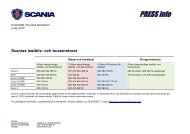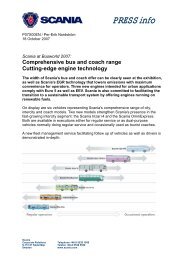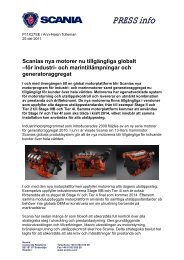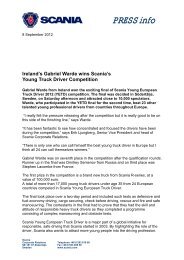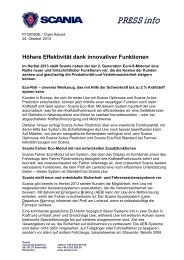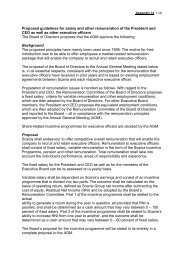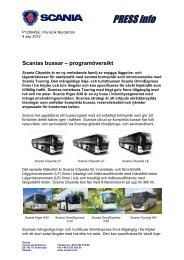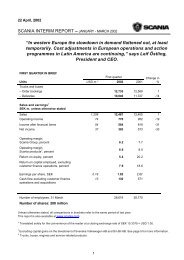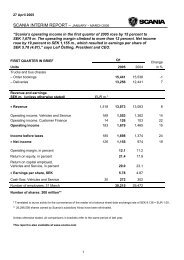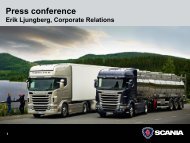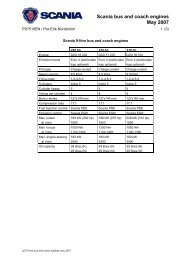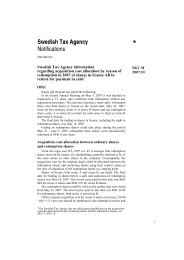Scania annual report 2004
Scania annual report 2004
Scania annual report 2004
Create successful ePaper yourself
Turn your PDF publications into a flip-book with our unique Google optimized e-Paper software.
World-class resources<br />
under one roof<br />
Customer needs are at the core of <strong>Scania</strong>’s research and development work. Today the<br />
company’s R&D resources in all product areas are gathered at the <strong>Scania</strong> Technical Centre<br />
in Södertälje.<br />
<strong>Scania</strong>’s research and development expenditures<br />
in <strong>2004</strong> totalled SEK 2,219 m.<br />
(2,151). Among other things, the 1,700<br />
engineers at the <strong>Scania</strong> Technical Centre<br />
have access to 29 engine test cells and<br />
nearly 20 km of test tracks. They also have<br />
chassis test rigs, shake rigs, cold and heat<br />
chambers, noise chambers and a wellequipped<br />
chemical analysis laboratory.<br />
Gathering all research and development<br />
at one site is advantageous in terms of<br />
staff utilisation and technical resources, as<br />
well as expertise and dissemination of<br />
knowledge. Testing and analysis are jointly<br />
planned for trucks and buses, as well as<br />
for industrial and marine engines. Staff and<br />
expertise are utilised cross-functionally in<br />
order to smooth out variations in the workload.<br />
Controlled by customer needs<br />
To find out about customer needs, <strong>Scania</strong><br />
uses a number of channels: customer<br />
clinics, interviews, field tests, monitoring<br />
of competitors and industry developments<br />
and <strong>report</strong>ing systems from its markets.<br />
Impulses for research and development<br />
work also emerge from <strong>Scania</strong>’s intensive<br />
quality monitoring at production units and<br />
in the field. R&D projects may also result<br />
from requirements imposed by public<br />
authorities or from future trends and<br />
development opportunities that <strong>Scania</strong><br />
identifies.<br />
Emissions the biggest challenge<br />
The biggest challenge – in terms of technology<br />
and resources – is to develop the<br />
engines of tomorrow. <strong>Scania</strong>’s solid reputation<br />
as a supplier of highly efficient, easyto-use<br />
engines is an important success<br />
factor, which has built up the <strong>Scania</strong> brand<br />
over the years.<br />
Here <strong>Scania</strong> has successfully defended<br />
and strengthened its leading position during<br />
the past decade, not least because of<br />
its transition to a completely modularised<br />
engine range. Today this range includes<br />
straight five- and six-cylinder engines with<br />
swept volumes of 9–12-litres, as well as a<br />
powerful 16-litre V8 engine with outputs of<br />
up to 580 hp.<br />
By developing a number of systems<br />
inhouse – among them fuel injection, engine<br />
management, turbocompounding and<br />
exhaust gas recirculation – <strong>Scania</strong> has<br />
created flexibility to meet the increasingly<br />
stringent environmental standards demanded<br />
by society and imposed by public<br />
authorities. These systems are utilised in<br />
different combinations, so that each engine<br />
is tailored for its application.<br />
Legislation mainly specifies threshold<br />
limits for two substances in heavy vehicle<br />
exhausts: nitrogen oxides and particulates.<br />
There is also an increasing focus on emissions<br />
of so-called greenhouse gases. Carbon<br />
dioxide emissions are directly proportional<br />
to a vehicle’s fuel consumption, and<br />
this leads to greater interest in fuel-efficient<br />
engines.<br />
The EU sets “Euro” emission standards.<br />
Euro 1 was introduced in the early 1990s,<br />
and Euro 4 standards will take effect soon<br />
– in 2005 for newly designed engines and<br />
in 2006 for all engines. The next step will<br />
be Euro 5 in 2008/2009. There are currently<br />
no global emission or testing standards.<br />
This leads to extra development work for<br />
global market players. However, both the<br />
heavy vehicle industry and public authorities<br />
are endeavouring to achieve coordination<br />
at a global level for the next step,<br />
which is projected to be due around 2012.<br />
The challenge for an engine developer<br />
is that decreasing nitrogen oxide emissions<br />
traditionally leads to higher fuel consumption.<br />
However, technological advances over<br />
the years have made it possible to gradually<br />
reduce emissions without adversely affecting<br />
fuel economy.<br />
RESEARCH AND DEVELOPMENT • SCANIA ANNUAL REPORT <strong>2004</strong> 30



